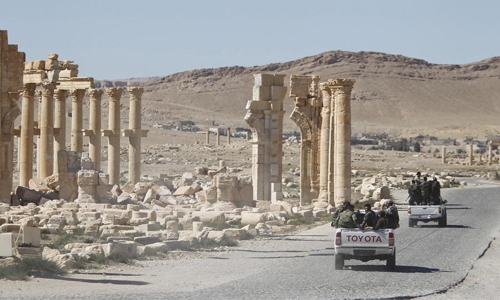Civil unrest destroys cultural heritage too
Unfolding in many of the ancient capitals of antiquity, an epic struggle for the soul of humanity is occurring in plain sight. Even before we factor in the chaos of modern-day Syria and Iraq, could there be a more depressing symbol of cultural cannibalism than the obliteration of mankind’s inheritance in the plunder of Mesopotamia, or the deliberate destruction of Palmyra? Yet a forceful riposte is emerging from the Middle East itself.
The fruit of a longstanding partnership between the UAE and France, Aliph – the International Alliance for the Protection of Heritage in Conflict Areas – constitutes a genuine call to arms to safeguard our collective birthright. Created just over two years ago after a conference in Abu Dhabi in December 2016 on the protection of endangered heritage, this ambitious enterprise could not be more timely, as obscurantist narratives spread worldwide, not just in the cradle of civilisation.
Governed by a foundation board and based in Geneva, Aliph is an alliance of sovereign states, including the UAE, Saudi Arabia, Kuwait, Luxembourg, Morocco, China and Switzerland, international organisations, private partners and leading experts in the field. With pledges worth more than $60 million already paid out, it finances the implementation of preventive care, emergency response and restoration programmes for cultural property at risk of destruction or damage. The foundation most recently announced its flagship project, the long-term restoration of the Museum of Mosul in Iraq.
In both spirit and purpose, Aliph emulates what is arguably the region’s most far-reaching cultural initiative – Louvre Abu Dhabi. In the UAE capital, Louvre Abu Dhabi represents a rare green shoot of determined idealism. Evincing the UAE’s resolve to share not only common interests but also common values between West and East, the museum provides remarkable insight into the conjoined history of mankind. From Islamic and Hindu art to illuminated Hebrew manuscripts and the recent addition of Rembrandt’s beautiful oil sketch Head of a Young Man in Prayer, depicting Jesus with his hands clasped in prayer, this joyful celebration of the profound interconnectedness of global civilisation since the beginning of time – a first in the Arab world – lifts our spirits and gives us hope.
But in its audacity, Louvre Abu Dhabi raises its own questions and forces us to reflect. At a time when erecting walls seems to be the fashion of the day, can the preservation of ancient heritage really build bridges between people? In an era of widespread scepticism about concepts such as enlightenment and universalism, can masterpieces of art truly advance a cause greater than mere accumulation or display? Perhaps the best answer to those questions might come from Fyodor Dostoyevsky’s The Idiot, a sort of prediction of the magnitude of precisely what Jean Nouvel’s architectural jewel aims to accomplish. “Beauty will save the world,” the book’s protagonist Prince Myshkin declares, in a comment that the reader is free to interpret as evidence of either insanity or brilliance.
All art is contemporary when it is created. Yet it might take decades, if not centuries, to determine what endures as “significant” in the arc of art history. The greatest artists surpass conventional realism and become transcendent. Members of that sacred pantheon – giants such as Shakespeare, Bach or Rembrandt – changed their mediums forever and, in doing so, made a contribution that changed the world. Amid the international celebrations marking the 350th anniversary of his death, Rembrandt is especially worth remembering for having bequeathed to the world a transcendent illumination that is both literal and figurative.
Arguably “the first to touch the soul” in painting, as the novelist and art theorist Andre Malraux put it, Rembrandt broke the bounds of convention and unleashed the imagination of the painter, casting off the classical limitations of expression and aesthetics to unveil a deeper narrative. Whether interpreting nobility or commoners, human or beast, the master connected intimately with the inner life of his subjects in a distinctly novel way – presaging by centuries the liberating breakthroughs of Impressionism and Expressionism.
Although controversial at the time, his revolutionary portrayal of the human condition and brushwork revealed a genius that enthralled and stirred legions of grateful luminaries – among them Goya, Delacroix, Van Gogh, Turner, Picasso, Rodin and Bacon – who in turn inspired the legions more that followed. The first acquisition by a public institution in the Arab world of a Rembrandt can be seen as an exclamation point on this year’s commemorations. May Louvre Abu Dhabi’s honouring of the master’s universal impact remind us all why our interwoven cultural tapestry represents an invaluable source of enlightenment and unity of purpose, and why this endowment must not only be protected but promoted.
Let it impress upon young and old the vital importance that museums and other places of wonder ought to assume in our lives, as well as the critical role that initiatives such as Aliph and Louvre Abu Dhabi play in the mission of not merely rejecting intolerance but embracing the mutual interdependence of humankind.
Related Posts

